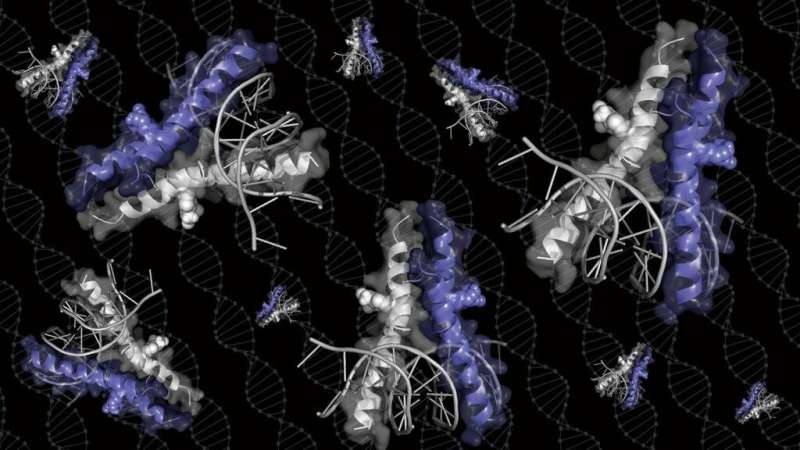New way to target 'undruggable' molecules involved in cancer

For decades, cancer researchers have longed for a way to target a set of proteins called transcription factors. While we've long known that tumors use these proteins to grow out of control, their unique configurations meant that for more than 30 years they had earned a reputation as "undruggable."
A group of University of Chicago scientists announced they have created an innovative way to build synthetic molecules that can target these previously "undruggable" transcription factors. The breakthrough, published Oct. 27 in Nature Biotechnology, holds promise for drugs and treatments as well as tools to better understand cancer biology.
"Doctors have had a hit list of transcription factors for decades, but we have lacked a way to target them," said UChicago chemist Raymond Moellering, the senior author on the study. "This work sets the stage for letting us go directly for any transcription factor."
'Undruggable' targets
As scientists have detangled the complicated workings of the cell, one thing that has become clear over the years is the importance of a class of proteins called transcription factors.
These proteins act like the pilots of the cell's DNA, deciding which parts of the genome to turn on and off and when. This is an enormous power, which means they are a prime target for cancerous malfunctions. For example, the role of one well-known transcription factor called Myc is to turn cell growth on and off. If a tumor manages to hijack Myc, it's like taping a brick to the gas pedal. The cells grow out of control.
"If you ask clinicians what they want in order to treat cancer, it's a way to inhibit Myc," said Moellering, an associate professor of chemistry whose area of expertise is developing new chemical tools and technologies to study proteins.
The problem is that Myc and its fellow transcription factors are big—made up of not just one protein, but several of them assembled together. The whole assemblies are so much larger than other proteins that scientists haven't been able to make traditional drugs work on most transcription factors. "Using the traditional drugs on transcription factors is like trying to get a foothold on a 50-foot vertical cliff," Moellering said.
So scientists wanted to build a synthetic transcription factor. If this molecule could sit on top of Myc's usual site on the genome, the researchers thought, it could prevent Myc from ordering the cell to grow out of control. But no one had managed to build a synthetic molecule that could do the job.
Moellering's lab took a new approach. They built a synthetic molecule that borrowed part of Myc's configuration—the claws that latch onto DNA.
"Right away when we ran the gels, we could see that we had cracked the code for the right configuration," said Moellering.
The synthetic molecules bind very tightly to Myc's landing point, preventing Myc from latching on. In petri dish tests, the molecules have successfully blocked the growth of cancer cells that are known to rely on Myc. These molecules are also compact enough to slip in and out of the cell, and stable enough to stick around for days before being broken down by the cell.
Customizable molecules
There is a long way before any molecule would be approved for use on humans, but they are seeing encouraging results in animal trials, the scientists said.
However, Myc is just one transcription factor. The team wanted to be able to customize the molecule to target many transcription factors. What they built is a customizable skeleton; based on their results, one could "reprogram" that skeleton to target a different DNA sequence and thereby affect a different disease-causing transcription factor.
This is partly because transcription factors aren't just important in cancer; they are involved in everything from aging to diabetes to autoimmune disease. "In other diseases, maybe you want to turn on a set of genes instead of turning them off; or block one and turn up another," said Moellering.
The synthetic molecules could also be used to help researchers better understand the mechanisms of cancer and other diseases—many of which remain mysterious.
"There are many different directions where you could imagine using platforms like this," said Moellering.
More information: Thomas E. Speltz et al, Targeting MYC with modular synthetic transcriptional repressors derived from bHLH DNA-binding domains, Nature Biotechnology (2022). DOI: 10.1038/s41587-022-01504-x
Journal information: Nature Biotechnology
Provided by University of Chicago


















